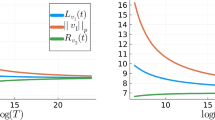Abstract
We show time lower bounds for both online integer multiplication and convolution in the cell-probe model with word size w. For the multiplication problem, one pair of digits, each from one of two n digit numbers that are to be multiplied, is given as input at step i. The online algorithm outputs a single new digit from the product of the numbers before step i + 1. We give a lower bound of \(\Omega(\frac{\delta}{w} \log n)\) time on average per output digit for this problem where 2δ is the maximum value of a digit. In the convolution problem, we are given a fixed vector V of length n and we consider a stream in which numbers arrive one at a time. We output the inner product of V and the vector that consists of the last n numbers of the stream. We show an \(\Omega(\frac{\delta}{w}\log n)\) lower bound for the time required per new number in the stream. All the bounds presented hold under randomisation and amortisation. Multiplication and convolution are central problems in the study of algorithms which also have the widest range of practical applications.
Access this chapter
Tax calculation will be finalised at checkout
Purchases are for personal use only
Preview
Unable to display preview. Download preview PDF.
Similar content being viewed by others
References
Clifford, R., Efremenko, K., Porat, B., Porat, E.: A black box for online approximate pattern matching. In: Ferragina, P., Landau, G.M. (eds.) CPM 2008. LNCS, vol. 5029, pp. 143–151. Springer, Heidelberg (2008)
Clifford, R., Sach, B.: Pattern matching in pseudo real-time. Journal of Discrete Algorithms 9(1), 67–81 (2011)
Daykin, D.E.: Distribution of bordered persymmetric matrices in a finite field. Journal für die reine und angewandte Mathematik 203, 47–54 (1960)
Fischer, M.J., Stockmeyer, L.J.: Fast on-line integer multiplication. In: STOC 1973: Proc. 5th Annual ACM Symposium Theory of Computing, pp. 67–72 (1973)
Fredman, M.L.: Observations on the complexity of generating quasi-gray codes. SIAM Journal on Computing 7(2), 134–146 (1978)
Fredman, M.L., Saks, M.: The cell probe complexity of dynamic data structures. In: STOC 1989: Proc. 21st Annual ACM Symposium Theory of Computing, pp. 345–354 (1989)
Galil, Z.: String matching in real time. Journal of the ACM 28(1), 134–149 (1981)
Kaltofen, E., Lobo, A.: On rank properties of Toeplitz matrices over finite fields. In: ISSAC 1996: Proc. of the 1996 International Symposium on Symbolic and Algebraic Computation, pp. 241–249 (1996)
Minsky, M., Papert, S.: Perceptrons: An Introduction to Computational Geometry. MIT Press, Cambridge (1969)
Paterson, M.S., Fischer, M.J., Meyer, A.R.: An improved overlap argument for on-line multiplication. In: Proceedings of SIAM-AMS, vol. 7, pp. 97–111. Amer. Math. Soc., Providence (1974)
Pǎtraşcu, M.: Lower Bound Techniques for Data Structures. PhD thesis, Massachusetts Institute of Technology (2008)
Pǎtraşcu, M., Demaine, E.D.: Tight bounds for the partial-sums problem. In: SODA 2004: Proc. 15th ACM/SIAM Symposium on Discrete Algorithms, pp. 20–29 (2004)
Pătraşcu, M., Demaine, E.D.: Logarithmic lower bounds in the cell-probe model. SIAM Journal on Computing 35(4), 932–963 (2006)
Yao, A.C.-C.: Probabilistic computations: Toward a unified measure of complexity. In: FOCS 1977: Proc. 18th Annual Symposium on Foundations of Computer Science, pp. 222–227 (1977)
Yao, A.C.-C.: Should tables be sorted? Journal of the ACM 28(3), 615–628 (1981)
Author information
Authors and Affiliations
Editor information
Editors and Affiliations
Rights and permissions
Copyright information
© 2011 Springer-Verlag Berlin Heidelberg
About this paper
Cite this paper
Clifford, R., Jalsenius, M. (2011). Lower Bounds for Online Integer Multiplication and Convolution in the Cell-Probe Model. In: Aceto, L., Henzinger, M., Sgall, J. (eds) Automata, Languages and Programming. ICALP 2011. Lecture Notes in Computer Science, vol 6755. Springer, Berlin, Heidelberg. https://doi.org/10.1007/978-3-642-22006-7_50
Download citation
DOI: https://doi.org/10.1007/978-3-642-22006-7_50
Publisher Name: Springer, Berlin, Heidelberg
Print ISBN: 978-3-642-22005-0
Online ISBN: 978-3-642-22006-7
eBook Packages: Computer ScienceComputer Science (R0)




